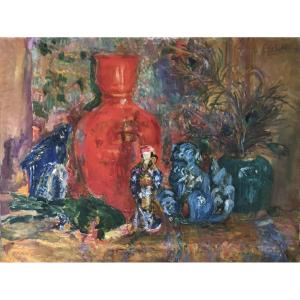Henry Lejeune, born Henri Émile Joseph Lejeune, is a Belgian painter, designer, and ceramist, born in Écaussinnes-d'Enghien in Hainaut in 1930 and died in Braine-le-Comte in 2014. In 1948, Henry produced his first paintings and entered as an apprentice at the Boch-Keramis earthenware factory in La Louvière, where he worked for 12 years as a worker. In the evening, he studied Decorative Arts at the Provincial Institute of Arts and Crafts under the direction of Ernest D'Hossche. In 1954, he met the artist Pol Bury in La Louvière and became friends with the poet Madeleine Biefnot, who was the muse of the surrealists from La Louvière, the mistress of the poet Franz Moreau and the companion of the teacher Jacques Duez. First surrealist paintings and ceramics. In 1970, he met the photographer Marcel Lefrancq and the painter Louis Van de Spiegele in Mons. These two surrealist artists from Hennuyers introduced him in 1971 to the designer Armand Simon with whom Henry Lejeune would maintain an intense friendship. In his use of colour, he sought the richness of the enamelled material that he had developed with ceramics. In 1972, he met André Blavier. In 1973, he joined the "Gradiva" group with whom he exhibited in Copenhagen and met the Provençal artists Philippe Garouste de Clauzade and Knud Viktor. JP Parent from Tournai made a film about him in 1983. In 1996, Henry Lejeune revisited the technique of ceramics to create sculptures in black terracotta. In 1998, he joined the surrealist group Phases. In 2000, he joined the Czech surrealist group as a guest of honor. Numerous exhibitions in Belgium, France, Switzerland, Czech Republic






































 Le Magazine de PROANTIC
Le Magazine de PROANTIC TRÉSORS Magazine
TRÉSORS Magazine Rivista Artiquariato
Rivista Artiquariato